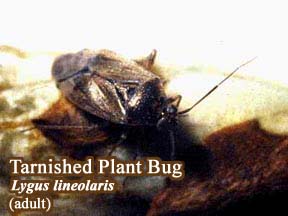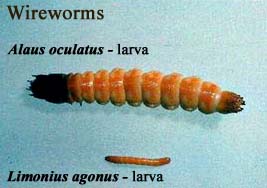Lettuce (Lactuca)
Plant Health Problems
Diseases caused by Fungi:
Seed decay and damping-off, Rhizoctonia solani, Pythium sp., Fusarium sp.
Seedlings either rot and do not germinate or germinate and collapse. The disease frequently attacks the base of the seedling and leaves a shriveled, dried-up stem at the base of the seedling.
Control can be achieved by using sterile potting media, clean pots, and fungicide-treated seed. If seeds in a seed tray become symptomatic, discard all of the seeds since asymptomatic seeds may be infected.
Root and crown rot, Rhizoctonia solani, Pythium sp., Fusarium sp.
Symptoms appear as wilting and a slow or rapid collapse of the plant. The roots can appear brown and water-soaked instead of white. A water-soaked lesion can often appear at the base of the stem.
Control can be achieved by using a two-year rotation with nonsusceptible plants, such as corn, to prevent the buildup of pathogenic organisms.
Drop rot, Sclerotinia sclerotiorum.
Drop rot causes the lower leaves to fall off. Eventually the stem rots through, and the whole head falls over in a slimy rot. The white, moldy growth of the fungus may be seen on the rotted head. Eventually the rotted mass may show the hard, black kernels called sclerotia which carry the fungus over in the soil from one year to the next. The disease is favored by heavy, wet soils.
To avoid the disease, plant in hilled-up rows, in light well-drained soils. Use a three-year crop rotation. The fungus which causes lettuce drop rot also attacks other crops, such as beans. Beets and onions are safe to use in rotation with lettuce. Among the compounds registered for use in Connecticut are dicloran, iprodione, and vinclozolin. Consult the label for dosage rates and safety precautions.
Bottom rot, Rhizoctonia solani.
This disease also rots the lower leaves of the plant, but does not destroy the stem. The head will not fall over if infected with bottom rot.
As the fungus which causes this disease is also favored by wet, heavy soils, control measures are the same as for drop rot. Among the compounds registered for use in Connecticut is iprodione. Consult the label for dosage rates and safety precautions.
Diseases caused by Bacteria:
Bacterial soft rot, Erwinia carotovora.
The first symptom of this disease is a rotting of the edges of the lower leaves. Finally the inner leaves of the head dissolve in a slimy rot. The bacteria which cause this disease live in the soil and are splashed up on the leaves by rain.
To avoid bacterial soft rot, plant in hilled-up rows, on well-drained soil. Use a three-year crop rotation.
Diseases caused by Phytoplasmas:
Aster yellows, phytoplasma.
Lettuce plants that have aster yellows have an abnormal number of leaves. The leaves are yellow, twisted, and stunted. The roots remain slender and have an abnormal number of fine hairy roots. Aster yellows of lettuce is caused by a bacterium-like organism called a phytoplasma and infects a wide range of hosts. The phytoplasma is carried by leaf hoppers.
To keep down the amount of disease, growers should control leaf hoppers with insecticides, control weeds around the edges of fields, and avoid planting lettuce near asters.
Diseases caused by Viruses:
Mosaic, virus.
Plants with mosaic are severely stunted and show a leaf mottle. This virus is usually seedborne.
Plant seed which is free of the virus.
Diseases caused by Nematodes:
Root-knot nematodes, Meloidogyne hapla.
Infected plants are stunted and sickly, with knots on their small, feeding roots. This disease is caused by nematodes which can persist in the soil for years.
Rotation with nonsusceptible plants, such as corn, can reduce the number of nematodes in the soil. Growing lettuce in a new area will also control the disease. Care should be taken to avoid carrying any soil from the old site to the new site.
Diseases caused by Physiological/Environmental Factors:
Tipburn.
As the name indicates, this disease shows as a scorch of the leaf edges. The disease is not caused by a microbe, but is an injury caused by high temperatures and humid weather. Tipburn usually appears at the time the summer crop matures.
Lettuce varieties resistant to tipburn, such as Ithaca and Mesa 659, are available on the market.
Insect Problems
Aphids.
Several species of aphids may occur on lettuce, some on the leaves and occasionally on the root. See Aphid fact sheet.
Aster leafhopper, Macrosteles quadrilineatus.
The adult leafhoppers are about 1/8" long and are light grayish-green or greenish-yellow in color. They can be distinguished from other leafhoppers by the six dark lines on the face. The primary damage is from transmission of a plant pathogen that causes aster yellows in the lettuce crop. Leafhoppers may also damage head lettuce directly, although leaf lettuce is less sensitive. Row covers can be used to exclude leafhoppers from the crop.
Cutworms.
Cutworms sometimes feed on young plants. See Cutworm fact sheet.
Garden slugs.
The leaves of lettuce and other garden plants may be eaten by slugs. These molluscs leave a slimy, iridescent trail wherever they crawl. Slugs are grayish, slimy, legless, and soft bodied, and vary in length from 1/2 - 4". They hide during the day and feed at night, notching the margins or cutting holes through the tender leaves.
Slugs require a great deal of moisture, so eliminating moist, dark hiding places can reduce slug damage. Caging or staking plants reduces the humidity around the plants and reduces slug damage. Using mulches, especially of moist organic materials around plants increases slug damage.
A flat board placed on the soil surface can be used as an attractive hiding place to trap slugs, which can then be removed and killed each morning. A shallow dish of beer, buried with the top edge level with the soil and with a cover to allow the entrance of slugs but keep out rain and light, is another effective trap. Barriers to movement of slugs can be made from copper strips, 4" wide and with one edge partially embedded in the soil. A strip of diatomaceous earth or sand 18-24" wide can also be used as a barrier, but must be renewed frequently, especially after a rain. A metaldehyde bait is among the compounds registered for control of this pest in Connecticut. Bait is distributed around the plants in the evening and may be more effective if used before any crops are planted. If plants are present, do not place the baits in contact with the edible parts of plants. To reduce the hazard to pets and birds, put the baits under boards or in bait stations that allow access to the slugs, but not to larger animals. Consult the label for dosage rates, safety precautions, and preharvest intervals.
 Tarnished plant bug, Lygus lineolaris.
Tarnished plant bug, Lygus lineolaris.
This general feeder may occasionally infest lettuce. This bug sucks sap from the tender leaves. The injury shows as darkened sunken areas about 1/4" in diameter on the leaves near the top of the plants. Feeding in the heart can also cause the death of young leaves, which may then be degraded by soft rot. The tarnished plant bug is a mottled brownish bug about 1/5" long that hibernates in protected places. The eggs are inserted in the tender tissues of leaves and buds, and the young bugs or nymphs are yellowish-green and pass through five stages before becoming adult. The adults are good fliers, and often move into vegetable crops from feeding on hayfields or weeds. A recently introduced parasitoid of the tarnished plant bug, Peristenus digoneutis, attacks the nymphs of the tarnished plant bug on alfalfa and may help to reduce populations moving into vegetable crops.
White grubs.
Like wireworms, these insects attack the roots of many crops. The larvae of several species of white grubs, which are the immature forms of scarab beetles, may cause injury by feeding on the roots. The grub is white, "C" shaped, has six legs, and a brown head. The eggs are generally laid in grasslands, and damage to crops is, subsequently, greatest when they are planted on land that has recently been taken out of sod. Native species have a 2- to 3-year life cycle and most damage occurs the year after the adults are abundant and lay their eggs. Exotic species (Japanese beetle, oriental beetle, Asiatic garden beetle and European chafer) have annual life cycles and can be damaging any year in which there is adequate moisture for egg hatch. By not planting susceptible crops on newly plowed sod land, most of the injury can be avoided.
 Wireworms.
Wireworms.
These general feeders may also attack the roots of lettuce. These shiny, hard-skinned, wire-like larvae are the immatures of click beetles. Wireworms feed on seeds and roots, producing weak plants. Several species of wireworms are involved and, like the white grubs, are more injurious to crops planted on soil that is the first or second year out of sod. The corn wireworm, Melanotus communis, or the wheat wireworm, Agriotes mancus, usually occur in heavier organic soils and tend to disappear with continued cultivation. Light sandy soils favor the eastern field wireworm, Limonius agonus. Continued cultivation encourages this species. The presence of wireworms in soil may be detected with baits, such as a cut potato, a mixture of untreated wheat and corn seeds, or rolled oats, buried a few inches deep in the soil, marked with a flag, then dug up 2-3 weeks later. If present in large numbers, they may also be visible when the soil is turned over.
Wireworms are difficult to control with available insecticides. Some tactics which may reduce damage are: 1) delay planting for several weeks after plowing so that little food is available, 2) use plastic mulch between rows to heat the soil above the wireworms' preferred temperature.

